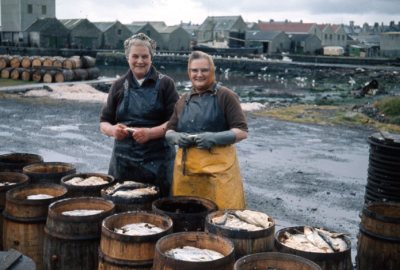The Gutters – here come the girls…
Girls as young as 14 were given their first taste of freedom, as they followed the migratory route of the herring from Shetland down the east coast of England, gutting and packing these highly prized fish by the barrel full.
It definitely wasn’t glamorous and the work demanded grit and sheer endurance, but the life of a ‘gutter lass’ offered independence and opportunity to women who had limited options when it came to earning power.
Girls as young as 14 were given their first taste of freedom, as they followed the migratory route of the herring from Shetland down the east coast of England, gutting and packing these highly prized fish by the barrel full.
Woken at 5.00am to the cry of ‘up lasses and wup your fingers’ the women would bind their fingers with material to protect them from the sharp knives and salt and then begin their long day, which, if the catch had been good, could go on until midnight.
Based in huts at one of the many curing stations, the gutters would work outside, unprotected from the elements. Despite the hardships and basic living conditions, the girls were renowned for their tough work ethic and strong sense of camaraderie.
The gutting and packing women were integral to the success of the herring fishery.

SHARE YOUR PHOTOS
Do you have any stories or photos to share about the gutter lasses? Please get in touch and let us know at info@somuchtosea.co.uk

Burra gutters in Lerwick in the 1930s. Photo shows, from left to right, Ruby Smith with Williamina Cumming and Jessie Smith

Burra lasses at the gutting in the 1930s. Back (L-R): Jessie Smith, Williamina Cumming, Mary Ann Fullerton. Front (L-R): Lily Jamieson, Ruby Smith and an unknown woman, possibly a visitor.

Studio photo: Burra gutters of the 1930s enjoying some time off. (L-R) Sisters Ruby and Jessie Smith with Williamina Cumming. Photo by Ramsay Studios.
![Gutting and packing herring in the late 1950s.[1]](https://seafoodshetland.co.uk/wp-content/uploads/2018/12/Gutting-and-packing-herring-in-the-late-1950s.1.jpg)
This photograph gives a great insight into the process of gutting and packing herring in the late 1950s.
The image was taken in 1959 at J&M Shearer Ltd., Curing Yard, Garthspool, Lerwick by Magnus Shearer.
The herring lasses are gutting the fresh herring which are lying in the ‘farlins’, having been salted by the coopers, and the lasses are selecting the various graded sizes as they gut, depositing them in the small tubs behind them. These are then moved across to the other women who are packing the herring into the wooden upright barrels.
The ‘bogie’ with the wicker herring baskets in the foreground was used to transport the herrings along ‘railway lines’ from the drifters lying alongside at Shearer’s pier. All the curing stations had a similar method as the herring boats used to go between them all, discharging their catches. This was the method used before the landings were concentrated at Alexandra Wharf and lorries were used to move the catches out to the Curing Stations.
